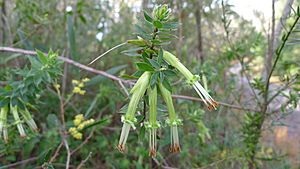Green five corners facts for kids
Quick facts for kids Green five corners |
|
|---|---|
 |
|
| Styphelia viridis at Waterfall | |
| Scientific classification | |
| Genus: |
Styphelia
|
| Species: |
tubiflora
|
Styphelia viridis, often called green five corners, is a unique plant found only along the east coast of Australia. It is part of the Ericaceae plant family. This plant gets its common name from its fruit, which looks like it has a flat top and five clear ribs. Its flowers are also green! These green flowers appear in autumn and winter. They are an important food source for honeyeater birds.
In 1803, a scientist named Henry Cranke Andrews described this plant. He was very impressed by the Styphelia plants from Australia. He thought there might be many different kinds of Styphelias, perhaps as many as the well-known Banksia plants.
Contents
What Does Green Five Corners Look Like?
Styphelia viridis is a small shrub that can grow up to about 1.8 metres (6 feet) tall, but it's usually much shorter. Its branches are stiff and covered with very fine, white hairs.
Leaves of the Plant
The leaves of this plant are similar to other Styphelia types. They are about 12 to 29 millimetres (0.5 to 1.1 inches) long. They are also about 2.9 to 7.6 millimetres (0.1 to 0.3 inches) wide. The leaves are shaped like a spear, getting narrower to a sharp point. The leaf stalk is short, about 1 to 2 millimetres (0.04 to 0.08 inches) long. The leaf blade itself is flat and smooth, with veins running parallel to each other.
Flowers and Fruit
The flowers of Styphelia viridis are a see-through bottle-green colour. The green sepals, which protect the flower bud, are about 8.5 to 16 millimetres (0.3 to 0.6 inches) long and smooth. The petals are joined together to form a tube. This tube is about 14 to 23 millimetres (0.6 to 0.9 inches) long. The ends of the petals roll back, showing the hairy inside of the tube.
The stamens (male parts) and the style (part of the female organ) stick out far beyond the tube. Both are about 10 to 16 millimetres (0.4 to 0.6 inches) long. The brown anthers, which hold pollen, are another 3.2 to 6.3 millimetres (0.1 to 0.2 inches) long. This plant flowers from April to August. After flowering, it produces its fruit. The fruit is a flat-topped, five-sided, greenish-red drupe.
Naming and Types of Green Five Corners
Styphelia viridis was first officially described in 1803. This description was made by Henry Cranke Andrews in his book The Botanist's Repository for New, and Rare Plants. The second part of its scientific name, viridis, is a Latin word. It means "green," which refers to the colour of its flowers.
There are two slightly different types, or subspecies, of Styphelia viridis:
- Styphelia viridis Andrews subsp. viridis: This type grows between Seal Rocks and Botany Bay in New South Wales. It has shorter anthers, about 4.8 to 6.8 millimetres (0.19 to 0.27 inches) long, and some other small differences.
- Styphelia viridis subsp. breviflora (Benth.) J.M.Powell: This type is found from Red Rock north into southern Queensland. It has slightly longer anthers, about 3.2 to 4.5 millimetres (0.13 to 0.18 inches) long.
Where Green Five Corners Grows
Styphelia viridis grows along the coast and in the mountain ranges of New South Wales and southern Queensland. You can find it growing in heathlands and dry sclerophyll forests. It prefers sandy soils.
Growing Green Five Corners
How to Grow This Plant
This plant is not very well known in gardens. However, you can grow it from seeds or from cuttings. If you want to grow Styphelia viridis, it needs a spot that is partly shaded. It also needs soil that drains water well and regular watering.

